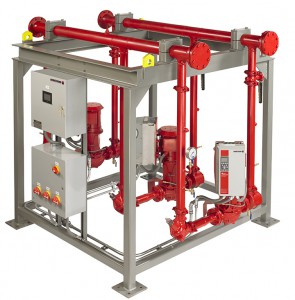By Dominic Cutts

Director – System Solutions, Armstrong Fluid Technology
Generating heat is an unavoidable outcome of electrical resistance within IT processors and, as IT processors become ever more powerful, the demand for cooling is rising. Chilled water cooling systems have a crucial role to play in dissipating heat to ensure server reliability and prevent downtime, but there is an environmental price to be paid. Overall energy demand of datacenters is escalating between 5% and 10% each year, and are responsible for 3% of the total electrical energy consumption in the UK. As a result, the environmental impact of datacenters has come under international scrutiny, with a number of organizations developing guidelines and regulatory frameworks for datacenter operation.
“Energy demand of datacenters is
escalating between 5% - 10% a year”
One such development is the PUE™ (Power usage effectiveness) metric, which provides a universal benchmark for datacenter environmental performance. It has been developed by The Green Grid Association (a non-profit, open industry consortium of end users, policy makers, technology providers, facility architects, and utility companies) and carries significant weight. It provides an at-a-glance picture of the efficiency of the energy consumed in the building both for processing and for cooling. A PUE of 1.5, for example, means that for every unit of power used on core IT equipment, an additional 0.5 units is spent on the supporting infrastructure.[1]
As the power relating to processing is difficult to reduce without impacting IT capability, it is the infrastructure/HVAC part of the metric which is the focus for increased efficiency. So how do you design HVAC systems for these critical cooling applications?
Three important priorities:
- Driving down wasted energy by moving away from capacity based control.
- Developing an incremental upgrade strategy that will alleviate wasted energy related to over-sized plants.
- Removing variables to improve reliability and consistent performance.
First of all, traditional capacity-based approaches to control of chilled water systems, designed around independent control loops, are not capable of delivering the levels of PUE demanded by today’s datacenters. Demand based control methodologies such as Hartman LOOP™ digital relational control, however, can achieve the requirements by treating the entire system ‘holistically’, rather than as individual sub-systems.
Key energy consuming components, such as Armstrong Design Envelope pumps, can be sequenced to operate along their peak efficiency natural curve for all load conditions. In addition, Hartman LOOP can calculate and determine the best power relationships between the chiller, condenser pump and tower fan. As well as ensuring the efficiency of individual components, this optimizes power relationships across the system, with equipment loading in one device traded off to pick up more load on another. This achieves the same net kWc for a lower kW input (a COP of greater than 7.0 compared to previous averages between 3.2 and 2.2), achieving significant improvements in PUE.
 |
| Armstrong iFMS |
Lastly, datacenters are bench-marked internationally using a reliability metric referred to as ‘The Nines’, which records a range of data such as percentages of IT equipment downtime. The supporting cooling systems play a key role in achieving the best possible IT integrity and must themselves offer outstanding reliability. Off-site manufacture has proved extremely effective in meeting these requirements. Assembling and integrating a complete chilled water plant room, or pump package, in the controlled environment of a factory, for example, assists the best possible quality of manufacture and component compatibility. Testing can be carried out in the factory under controlled conditions prior to delivery, and the best solutions incorporate fail-safe features. Armstrong’s self-contained IPP-CHW fully-integrated chilled water plant package, for example, is a popular solution.
Whilst the guidelines issued by Green Grid and others (such as the EU Code of Conduct on Datacenters' Energy Efficiency) are currently voluntary rather than mandatory, they provide powerful commercial advantages for those datacenter operators able to differentiate themselves through environmental performance. By adopting best practice approaches such as demand-based control, modular system design and off-site manufacture, HVAC partners can be the key to wider commercial success for the datacenter operator, as well as enhancing carbon footprint.
[1] AMA Research, ‘UK Datacenter Construction Market Report’, February 2014




